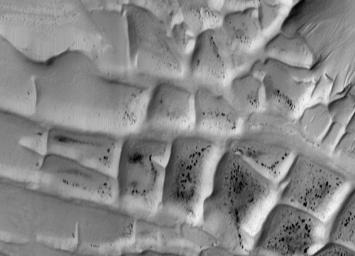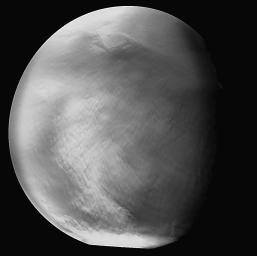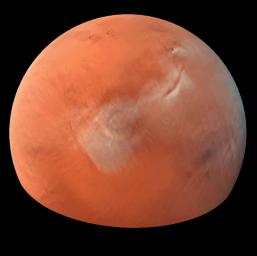
Mars
Since recorded time, Mars has been the topic of discussion with astronomers. This redish planet with its swift movements in the sky was marked as a special planet. Through telescopes you can se polar caps, dust storms and permanent markings. All this made astronomers believe that Mars is the most likely home of extraterrestrial live in our Solar System. This was portrayed in the famous War of the Worlds.
Since then various missions has gone and even landed on Mars. They found Mars to be a cross between the earth and the moon without any detectable life on it. It has ancient craters, giant canyons and massive extint volcanoes. The air contains about 1/1000 as much water as our air. Even this small amout condenses out forming clouds. Patches of fog forms in the valleys and even frost covering the ground in winter was seen. As mentioned earlier, Mars has polar caps. The photo below shows the ice layer on the south pole of Mars.

As seen from the photo below, Mars is a truly a red sandy planet.
This photo was taken by Viking I. Click on the image to get a larger different photo from Mars. The following two photos shows the cloud cover and how that changes with one of Mars's famous dust storms.


Orbiting Mars is the Mars Global Surveyor. This spacecraft has been maping the surface of Mars. It found real hard evidence that Mars had a denser atmosphere in the past that allowed water to flow on the planet. There are physical features that closely resembles shorelines, riverbeds, gorges and even islands.
Since 1960 there has been 27 missions to Mars. Not all of them were succesfull, but the succesfull ones enabled us to learn a lot about Mars. So why are we doing this ? The answer is quite simple... So that we can send humans to Mars. At first it might only be to explore, but the establishment of settlements on Mars is also possible.
| Planetary Data of Mars | |
| Rotation Period (Equatorial) | 24 h 37 min 22.6 sec |
| Average distance from sun | 227 900 000 km |
| Sidereal Orbit Period | 687 days |
| Sidereal Rotation Period | 24.6229 hours |
| Average Orbital Velocity | 24.13 km/sec |
| Radius of Planet (Polar) | 3375 km |
| Radius of Planet (Equatorial) | 3397 km |
| Mass of Planet | 6.42 x 10²³ kg |
| Density of Planet | 3933 kg/m³ |
| Temperature (Daytime max) | 20ºC |
| Temperature (Night max) | - 140ºC |
| Atmosphere | 95.32%
Carbon Dioxide,
2.7% Nitrogen, 1.6% Argon, 0.13% Oxygen |
| Satellites | Phobos,Deimos |